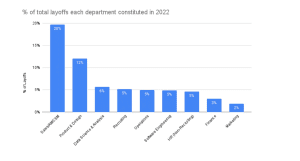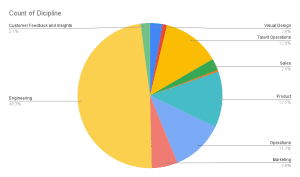
It seems January was not a good month for the tech sector. When compared to the last few months of 2022, the month of January had the highest count of layoffs in the industry. While these layoffs continue to tell us something about the correction happening in the tech industry in the U.S. and elsewhere, they don’t necessarily tell the whole economic story.
Inevitably, big-name companies like Amazon, Google, and Microsoft laying off thousands of employees will cause a stir and cause nervous rumblings throughout the industry and beyond. The U.S. is not the only country that has suffered layoffs in tech companies or emerging startups. Still, digital transformation continues afoot throughout all sectors of the economy and that means companies need to hire software engineers, developers, and tech professionals.
The Mexico tech industry and Latin America continue to see growth from increased demand in technical skills and from U.S. companies seeking highly-trained talent.
The Tech Industry and the Big Picture
The tech industry is front and center, but it does not comprise the biggest chunk of the economy. While the tech industry contributes heavily to the country’s GDP, it does not comprise the biggest chunk of the workforce. According to the U.S. Bureau of Labor Statistics industries that employ bigger percentages of the workforce include manufacturing, construction, healthcare, and the professional and business service sector. That being said, as construction, manufacturing, healthcare, and government continue their digital transformation and technological solutions, software developers and engineers continue to be essential.
That doesn’t discount, however, the very real fears and trepidation surrounding the economy and growth in 2023. Fears of a recession have been in the ether since 2022 when things decidedly began to slow down and inflation reached record highs.
What Types of Companies are Laying Off Employees?
Some of the hardest hit companies are big household names like Amazon, Google, and IBM. According to the layoff tracker, January certainly saw a spike in layoffs compared to the final months of 2022.
Why are Companies Laying Off Employees Now?
The reasons for the layoffs vary. Most of these companies are undergoing a correction to what is now known as the covid hiring spree or hiring frenzy (it is referred to by a variety of names.) Several of the companies that enacted layoffs cited economic conditions, inflation, and interest rates. Various layoff timelines and deep dives have since emerged trying to keep track of the numbers and measure the extent of the damage, which is often hard to measure against the industry’s complicated full picture.
Below are some of the reasons that the biggest companies cited for having to downsize.
Meta
Mark Zuckerburg’s Meta had a headcount of about 87,000 when it announced the cuts in November. It would be slashing about 13% of its workforce, sending home about 11,000 people. Zuckerburg stated in a statement that the cuts were due to a miscalculation of the acceleration that happened during covid, as well as increased competition, and external macroeconomic conditions.
IBM
The technology company laid off 3,900 employees, which equaled about 1.5% of its workforce. The company claimed that the layoffs had more to do with a spinoff and healthcare divestiture it had engaged in rather than any other reasons.
Alphabet announced its cuts of 12,000 jobs in January of 2023. This number equals to about 6% of the company’s global workforce. The CEO said that dramatic growth in the past two years led the company to hire for a very different economic reality than what we have today.
Microsoft
It didn’t take long into the new year for one of the biggest tech companies to announce their layoffs. On January 18, Satya Nadella of Microsoft confirmed the company was letting go of 10,000 employees or 5% of its workforce. The company cited slow growth in the first quarter of its fiscal 2023 as the leading reason for the decision.
Salesforce
Similarly, Salesforce announced its round of layoffs in early January. They suggested they would have to let go of 8,000 workers, which equals to about 10% of their roster.
Who is Getting Laid Off?
So while media reports simply cite layoffs at tech companies, not all laid-off positions are direct tech jobs. Many of these companies employ big marketing, sales, and recruiting departments that are often the first ones to get slashed.
According to interviewing.io, the data pointed to other departments being the hardest hits in these layoffs. Based on what they analyzed in the data, the departments that were most affected were Sales, Product and Design, and Data Science and Analysis. Their analysis ended in August of 2022, but, of course, layoffs have continued since then.

Source: Interviewing.io
In our own effort to dig into the data, we looked at a sample of 3,000 recently laid-off employees. These are from the self-reported lists on the layoff tracker.

Note: That’s an important point: these are self-reported lists and therefore do not include all employees that were laid off from any one company. The lists are incomplete and may offer only a few of the total laid-off in a particular company.
In the end, it is difficult to tell exactly what positions are most affected overall, given the limited data. It does seem, however, that perhaps companies are having to reduce their engineering teams given their need to cut costs. Data seems to suggest, however, that laid-off engineers and specialized talent quickly recover jobs.
And yet, departments such as marketing, sales, and recruiting continue to be what are often the most vulnerable positions.
What’s Next For Tech Hiring and Growing Companies?
Despite some of the difficulties in sifting through the data, a lot of evidence points to the fact that the tech industry is robust, despite some recent setbacks. Even companies that have laid off thousands of workers, like Microsoft, are investing in other ways (such as Open AI) that indicate there is still plenty of potential to grow. Perhaps the growth will look differently and take new shapes.
As people have pointed out, a lot of traditional organizations are catching up with their use of technology. Newstack.io discusses just how automotive electronics, space, oil, and gas are updating their systems and software, migrating to more sophisticated languages or platforms.
The Mexico IT Industry and the Nearshoring Market
As a talent solutions partner that works in the nearshoring market, we often see things from a unique angle and how the changes in the U.S. market can impact the rest of the surrounding markets.
During the covid growth, tech companies often reached out to Mexican software developers to fill necessary positions or supplement their ground team in the U.S. From what we can see in the layoff trackers, the LATAM country with the most layoffs was Brazil.
As of now, the nearshoring market is still strong. Mexico’s tech talent frequently works with U.S. companies. According to our recent survey, 79.6% of Mexican tech professionals prefer and seek to work with a foreign company. This has led to high levels of English, training, and proficiency of in-demand technologies and languages.
Hiring Remote Software Engineers with a Complicated Talent Pool
Nearshoring to Mexico is a viable option for companies that are worried about increased costs but need specialized talent to fill positions.
If your company is looking to hire tech talent, our team can help you find the right fit.


